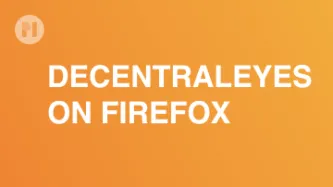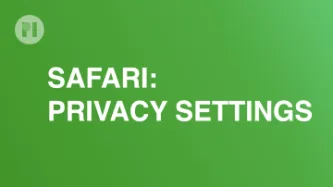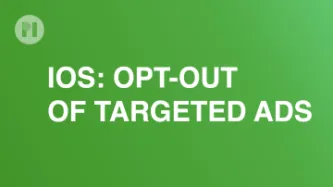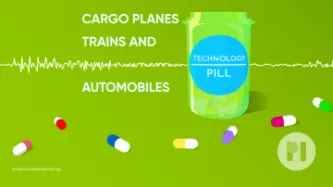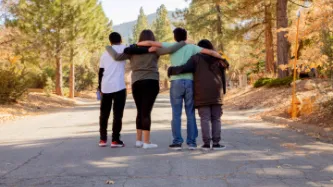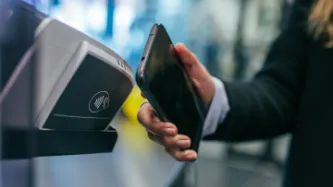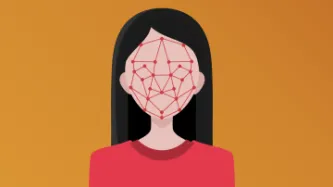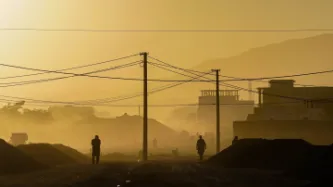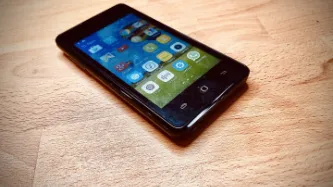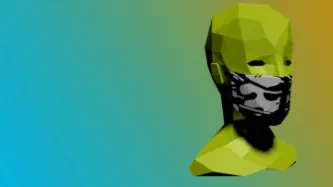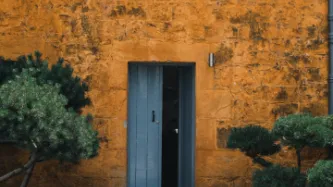Advanced Search
Content Type: Guide step
Las cookies permiten que los sitios web guarden los datos de una sesión, como las credenciales de acceso o los artículos en el carrito de compras, con el propósito de que no pierdas la información al cerrar la página. Desafortunadamente, con frecuencia se abuse de las cookies para rastrear tu actividad en línea en la web. Utilizar una extensión especializada te permite limpiar las cookies con regularidad para asegurarte de que tu navegador no guarde ninguna cookie no deseada, lo que permite…
Content Type: Guide step
Las redes de distribución de contenidos (CDN) son redes geográficamente distribuidas de servidores proxy que buscan ofrecer funciones como mejorar la disponibilidad y el rendimiento de los sitios web. Aunque el objetivo es loable, también implica que los proveedores de CDN reciben metadatos vinculados con los sitios web que visitas (donde están instalados). Sabiendo esto, quizá sea conveniente sacrificar estas ventajas adicionales y prescindir de los grandes proveedores de CDN (como Google y…
Content Type: Guide step
uBlock Origin (que no debe confundirse con uBlock, que es un proyecto diferente) es un bloqueador de anuncios independiente y de código abierto que utiliza una lista depurada de servidores. Evita que tu navegador se conecte a estos servidores para mostrarte anuncios.
Nota: En el mercado hay muchos bloqueadores de anuncios y puedes ensayar alternativas. Al utilizar un bloqueador de anuncios independiente, de código abierto y gratuito, es más probable que evites usar productos con conflictos de…
Content Type: Guide step
Privacy Badger es una extensión para el navegador que bloquea los anuncios y los rastreadores. Esta extensión lleva una lista actualizada de los rastreadores que detecta mediante pruebas automatizadas (realizadas través de servidores especializados y no desde tu computador) y periódicamente envía la lista actualizada a tu navegador. De este modo, cada vez que detecta un servidor de anuncios nuevo (por ejemplo, si una nueva empresa de rastreo lanza su producto o una empresa ya existente…
Content Type: Guide step
Cómo cambiar la configuración en el menú de Firefox
Para cambiar la configuración básica de privacidad en Firefox, accede al menú de preferencias haciendo clic en Edición > Preferencias en la barra de menús, o escribiendo about:preferences en la barra de URL, y luego haciendo clic en Privacidad y seguridad (Fig. 1)
Content Type: Guide step
Advertencia: Con macOS Big Sur, Apple amplió el soporte para las extensiones del navegador, las cuales ya están disponibles en la App Store. Aunque el ecosistema de herramientas de privacidad sigue siendo reducido, es posible que actualicemos esta guía en el futuro.
Para acceder al menú de configuración, abre la aplicación Safari y en la barra de menú haz clic en Safari > Preferencias... (Fig. 1).
Content Type: Guide step
Atención: Si usas iOS 14+, los anuncios personalizados están activados por defecto.
Cómo detener el rastreo realizado a través de múltiples apps en iOS
Ya hemos escrito con anterioridad sobre los riesgos que los anuncios personalizados suponen para tu privacidad digital.
Si quieres detener el seguimiento entre múltiples aplicaciones, el primer paso es ir a Configuración > Privacidad > Rastreo. Aquí, asegúrate de desactivar Permitir que las apps soliciten rastrearte DESACTIVAR (Fig.1).…
Content Type: Guide step
Blokada es un bloqueador de anuncios que actúa como una VPN para bloquear el tráfico no deseado con base en hostnames (urls). Esto evita que las aplicaciones ejecutándose en tu dispositivo carguen anuncios y datos maliciosos.
Instalación
Para instalar Blokada, visita su página en la App Store de Apple, haz clic en Obtener (Fig. 1), y confirma haciendo clic en Instalar (Fig. 2).
Content Type: News & Analysis
Introduction
The European Parliament has adopted a nonbinding resolution against the use of artificial intelligence (AI) by law enforcement in public spaces and a ban on facial recognition databases, such as the ones used by Clearview AI.
It is a significant and hugely welcome step in an ongoing campaign to ensure the EU leads the world in protecting against dangerous applications of AI within its borders.
The Resolution recognises the need to safeguard against application of AI and mass…
Content Type: Advocacy
The UK government proposes to establish a dedicated Digital Markets Unit to implement and enforce the new pro-competition regime for digital markets. The Digital Markets Unit will be responsible for designating companies with 'Strategic Market Status', overseeing a mandatory code of conduct for those companies and implementing pro-competitive interventions
The way digital marketplaces are shaped has a tremendous impact on human rights. However, this perspective is not always sufficiently…
Content Type: Examples
Vaccinating a large portion of the population against COVID-19 is a critical step toward curbing the pandemic – within China and around the world. But setting population percentage targets without clear protections for people’s rights opens up the possibility of authorities abusing the quota to force jabs. And this is exactly what has played out in recent months across the country.
The Chinese government’s forced vaccination tactics, which go far beyond “mandates” being debated and discussed…
Content Type: Advocacy
Some of the most vulnerable groups in Mexico are amongst the groups at risk from a draft General Population Law that creates a biometric “Unique Digital Identity Card” (CUID), argue civil society organisations. The proposed law has now reached the senate, and has raised serious concerns from civil society organisations. Led by our global partner in Mexico Red en Defensa de los Derechos Digitales (R3D), PI along with 25 organisations have signed a joint letter to the members of the senate,…
Content Type: News & Analysis
Photo by Emmanuel Olguín on Unsplash
After many denials and much distraction, the truth is out. According to Facebook’s own internal research, Instagram is toxic to teen girls’ mental health.
This week, the Wall Street Journal reported on a collection of internal Facebook documents which it says demonstrate how the platform is acutely aware of the harmful effects Instagram has on the mental health of teens. The Journal reported that Facebook’s own research showed that use of the image…
Content Type: Video
<br />
Links
Lucie's recommedations
A history of Western Philosophy by Bertrand Russel
John le Carré
La Horde du Contrevent by Alan Damasio
The Right to Choose by Gisèle Halimi
Clara's recommendations
Dandelion Wine by Ray Bradbury
Republic of Lies by Anna Merlan
Tranny: Confessions of Punk Rock's Most Infamous Anarchist Sellout by Laura Jane Grace
Millie's recommendations
You might recognise Millie's voice from our Phone Extraction podcast
Cack-…
Content Type: Long Read
Image found here.
Founded in 1959, Bounty UK Limited markets itself as an information service for pregnant women and new mothers. Prior to the pandemic, it was best known for distributing “Bounty packs” of free samples of baby products to pregnant women at midwife appointments, to new mothers on maternity wards in the UK and through its digital presence via its website and app. Bounty representatives also sold new born photography packages to new mothers at the hospital bedside. Bounty entered…
Content Type: Long Read
Introduction
Technology has driven a number of changes in the way that financial services are packaged and accessed by consumers. These changes have led to the rise of fintech, a data intensive industry that has been touted for its convenience and as an alternative to traditional financial services.
The current article looks at the use of digital loan Apps in Philippines and Kenya and contextualises the global discussions on fintech which we have been monitoring for some years. Research…
Content Type: Examples
The provincial government of Khyber Pakhtunkhwa announced that it would block the mobile phone SIM cards of people in five districts of Peshawar division which were not vaccinated by the deadline set of 31 August 2021.
Officials justified this decision following the low numbers of people coming to the 800 vaccination centres in the province despite many initiatives led by the district administrations and health department to improve Covid-19 vaccination rates.
Source: https://www.dawn.com/…
Content Type: Advocacy
PI, together with 30 national and international civil society organisations (CSOs), release an open letter calling on Parliament and relevant stakeholders to halt and ban the use of live facial recognition technology (LFRT) by the police and private companies.We believe that the use of LFRT poses significant and unmitigable risks to our society. We do not believe that it can ever be safely deployed in public spaces or for mass surveillance purposes.The open letter comes as a result of a recent…
Content Type: News & Analysis
After almost 20 years of presence of the Allied Forces in Afghanistan, the United States and the Taliban signed an agreement in February 2020 on the withdrawal of international forces from Afghanistan by May 2021. A few weeks before the final US troops were due to leave Afghanistan, the Taliban had already taken control of various main cities. They took over the capital, Kabul, on 15 August 2021, and on the same day the President of Afghanistan left the country.As seen before with regime…
Content Type: Press release
Dear TECNO,
We, the undersigned, don’t believe that privacy should be a luxury. And yet, when TECNO manufacture and sell phones with an outdated operating system, that’s the world TECNO are helping to create.
Our recent investigation into the TECNO Y2 showed that at least one TECNO phone is currently on sale with an operating system that hasn’t received updates since 2013. We are concerned because this is leaving users vulnerable to hundreds of well-known and serious exploits.
The Y2 was…
Content Type: Advocacy
Dear TECNO,
We, the undersigned, don’t believe that privacy should be a luxury. And yet, when TECNO manufacture and sell phones with an outdated operating system, that’s the world TECNO are helping to create.
Our recent investigation into the TECNO Y2 showed that at least one TECNO phone is currently on sale with an operating system that hasn’t received updates since 2013. We are concerned because this is leaving users vulnerable to hundreds of well-known and serious exploits.
The Y2 was…
Content Type: News & Analysis
Our relationship with ‘public space’ is being redefined, not just by a global pandemic, but also by a new era of biometric surveillance technologies. Biometric mass surveillance enables companies and authorities to track us based on unique personal data and identify us whenever, wherever we go.The increasing use of facial recognition and other biometric surveillance technologies – on our streets, in train stations, at protests, at sports matches and even in our global ‘town square’, Facebook –…
Content Type: Long Read
India’s Mother and Child Tracking System (MCTS) is a system that collects vast amounts of data about pregnant people, children, and families. It is an initiative by the Ministry of Health and Family Welfare in India, and was first trialled in 2009. It was then rolled out nation-wide in 2011. Its declared purpose, as stated in the press release accompanying it, was to facilitate “ensuring timely delivery of full spectrum of health care services to pregnant women and children up to 5 years of age…
Content Type: Press release
Privacy International research released today shows that the brand new TECNO Y2 phone is being sold with outdated versions of the Android operating system. The version of Android, which is from 2013, no longer receives security updates, and contains over 200 known vulnerabilities. The phone also comes with pre-installed apps that the users cannot uninstall. What this means is that the privacy and security of people using TECNO’s Y2 phones can be at risk.
TECNO are a phone manufacturer based in…
Content Type: Long Read
When you buy a brand-new low-cost phone, it’s likely to come pre-installed with insecure apps and an outdated operating system. What this means is that you or your loved ones could be left vulnerable to security risks or to having their data exploited. Privacy shouldn’t be a luxury. That’s why we advocate for companies to provide the latest security features and privacy protections for both low- and high-cost phones.
Content Type: Advocacy
On 6 August 2021, the World Health Organisation (WHO) published its technical specifications and implementation guidance for “Digital Documentation of COVID-19 Certificates: Vaccination Status” (DDCC:VS) following months of consultations. As governments around the world are deploying their own Covid-19 certificates, guidance from the global health agency was expected to set a global approach, and one that prioritises public health. As such, we would expect the WHO to identify what these…
Content Type: News & Analysis
Today Apple announced a set of measures aimed at improving child safety in the USA. While well-intentioned, their plans risk opening the door to mass surveillance around the world while arguably doing little to improve child safety.
Among the measures, Apple has announced that it is to introduce “on-device machine learning” which would analyse attachments for sexually explicit material, send a warning, and begin scanning every photo stored on its customers’ iCloud in order to detect child…
Content Type: Long Read
For many, browsing the internet or checking social media comes with its fair share of being targeted with ads selling “fad diet” subscription-based programmes, magic weight-loss powders, or promising a secret trick to lose weight quickly. Some of the products and programmes sold have been described as scams, with a very real impact for those suffering from eating disorders and those who fall prey to these ads. This is even more problematic due to the Covid-19 pandemic, which has seen the…

